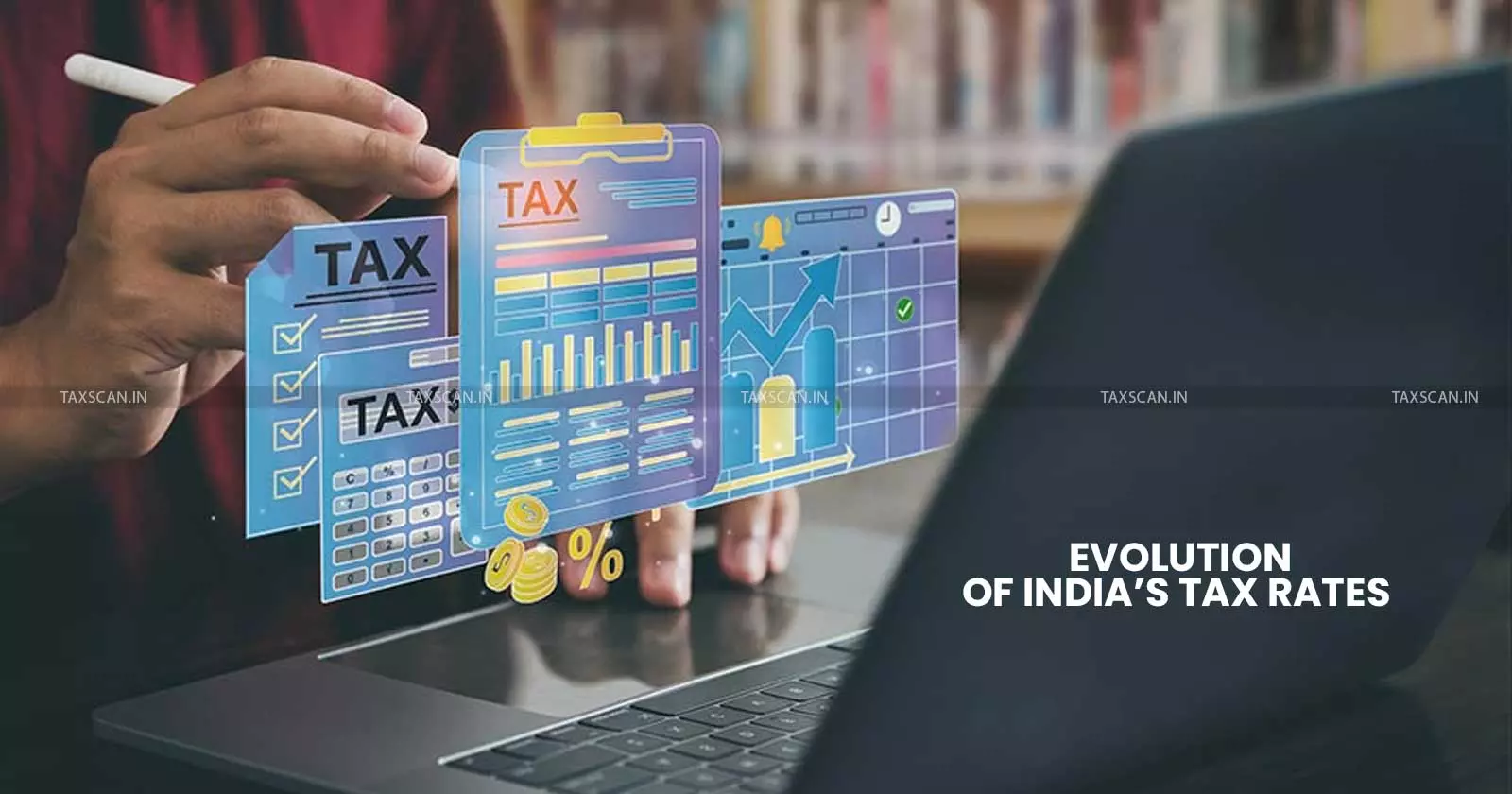Evolution of India’s Tax Rates Since Independence
India has moved from punishingly high rates to levels that now stand alongside global norms, shaped by changing ideologies, economic shocks, and the need to modernise

Introduction
Taxation in India has been on quite a journey since Independence. Its early years were characterized by a strong emphasis on steep rates intended for redistribution in an effort to address severe economic disparities. This eventually gave way to a number of changes aimed at simplifying, enhancing equity, and better coordinating taxes with economic expansion.
Every change in tax policy, from the socialist-inspired decades of high personal and corporate tax slabs to the quest for efficiency during the liberalization era, represents a turning point in India's political, social, and economic development. In what follows, we map the big shifts in tax rates from 1947 to 2025, explain why each reform happened, and consider how these choices changed the economy.
1. Early Years: Independence to Early 1960s
After independence in 1947, India inherited a colonial tax structure primarily reliant on wealth and high income taxes. In 1950-51, the highest marginal income tax rate was set at 25% ; modest by future standards. Although this was meant to aid in the development of the country, it was a reflection of the narrow income distribution and dearth of significant domestic business activity
Key Characteristics:
- Simplicity and lower maximum rates.
- Few tax slabs with moderate taxation.
2. The Socialistic Surge: 1960s to Mid-1970s
As India adopted more pronounced socialist planning, there was an aggressive increase in the highest tax rates:
- Early 1960s: The highest rate quickly escalated, touching 88%.
- Early 1970s: Under Prime Ministers Indira Gandhi and finance ministers like Y.B. Chavan, rates reached their historic maxima:
- 1971-72: 93.5%
- 1972-75: record-breaking 97.75%, one of the world’s highest nominal rates ever!
Rationale: Heavy taxation was designed to finance public spending, reduce inequality, and fund rapid industrialisation.
Understanding Common Mode of Tax Evasion with Practical Scenarios, Click Here
Consequences:
- Severe incentive erosion for entrepreneurs and professionals.
- Proliferation of tax evasion and black money.
- Arbitrage through loopholes and widespread avoidance.
3. Gradual Rationalisation: Late 1970s to Late 1980s
Mounting criticism of punitive tax policies led to a gradual softening:
- 1974-75: The highest rate was lowered from 97.75% to 75%.
- Early 1980s: The rates continued to come down; by 1980-81, the top rate was 72%.
- 1985-86: Then Finance Minister Vishwanath Pratap Singh (Fmr Prime Minister Too) reduced the number of tax slabs from 8 to 4 and cut the highest marginal rate to 50%.
Key Changes:
- Introduction of more reasonable slab structures.
- Focus was on tax base expansion and improved compliance.
4. During LPG Era: 1990s
Economic crisis in 1991 became a watershed for tax reforms:
- 1991-92: Introduction of broad-based reforms—reducing top marginal personal and corporate tax rates to 40%.
- 1997-98: Chidambaram's "Dream Budget" saw the maximum personal tax rate fall to 30%, marking a historic low since highs of the 1970s.
Driving Principles:
- Attracting investment, both foreign and domestic.
- Shifting towards a growth-friendly, compliance-driven regime.
- Simplification of slabs: reduced from a maze of 11 slabs (1970s) to as low as 3 by the end of the 1990s.
Economic Impact:
- Expanded tax base and increased collections despite lower rates.
- Encouraged entrepreneurship and formal sector jobs.
5. New Millennium Reforms: 2000s to 2010s
Tax system modernisation gathered steam:
- 2005-06: Exemption limits raised, slabs further simplified.
- Example (2005-06): Income up to ₹1 lakh tax-free; ₹1–1.5 lakh: 10%; ₹1.5–2.5 lakh: 20%; above ₹2.5 lakh: 30%.
- Post-2010: Higher exemption limits, wider slabs.
- For FY2010-11: Income up to ₹1.6 lakh exempt; ₹1.6–5 lakh: 10%; ₹5–8 lakh: 20%; above ₹8 lakh: 30%.
Major Indirect Tax Reforms:
- Introduction of VAT (2005): Replaced cascading state sales taxes.
- Progress towards Goods and Services Tax (GST) announced.
6. Transformative Tax Reforms: 2017 Onwards
a. Introduction of GST (July 1, 2017)
- Unified over a dozen indirect taxes into a single nationwide tax.
- Abolished the complexity of multi-layered taxes on goods and services.
- Enhanced compliance, transparency, and inter-state commerce.
- Short-term inflationary pressures, but long-term reductions in cost for many sectors.
b. Corporate Tax Reforms (2019)
- Corporate tax for domestic companies was reduced to 22% (without exemptions).
- New manufacturing companies were taxed at historically low 15% to boost investment.
c. Recent Personal Tax Slabs and Rationalisation:
- 2019-20: Top effective rate hovered around 43% (including surcharges).
- 2025 (New Tax Regime): Seven slabs introduced to simplify the system:
- Up to ₹4 lakh: NIL
- ₹4–8 lakh: 5%
- ₹8–12 lakh: 10%
- ₹12–16 lakh: 15%
- ₹16–20 lakh: 20%
- ₹20–24 lakh: 25%
- Above ₹24 lakh: 30%.
Understanding Common Mode of Tax Evasion with Practical Scenarios, Click Here
7. Rationale and Impact of Reforms
Why These Changes?
- High rates in the 1970s–80s resulted in poor compliance, tax evasion, and underdevelopment of the formal sector.
- Rationalisation and simplification led to:
- Higher compliance and collections; even at lower rates.
- Growth in the formal economy.
- Investment-friendly environment.
- Lessening of wealth flight and black money.
Broader Socio-Economic Impact:
- Boost in GDP growth post 1991 (GDP from $270 billion in 1991 to $2.9 trillion by 2020).
- GST integration led to “One Nation, One Tax,” reforming logistics and cost structures for enterprises.
- Sharper separation between direct (equitable, as per ability to pay) and indirect taxes, shift in revenue composition towards direct taxes post-1991.
8. Ongoing Challenges and The Way Ahead
Despite reforms, certain issues remain:
- Compliance and tax disputes: The “Direct Tax Vivad se Vishwas” scheme (2020) aimed at dispute resolution.
- Scope for further simplification and improving tax base by plugging loopholes and expanding digital compliance.
- Structural GST challenges: Rationalising GST rate slabs, increasing ease of compliance, and reducing litigation.
- Ensuring that future reforms continue to balance revenue requirements with economic growth and equity.
Summary Table: Landmark Milestones in Taxation
| Year | Max Rate (%) | Key Development |
| 1950-51 | 25 | Early post-Independence rates; moderate slabs |
| 1960s | 88 | Rate surge with socialist policies |
| 1971-75 | 93.5–97.75 | All-time highs for redistribution (Indira Gandhi era) |
| 1974-80 | 75–72 | Beginning of gradual reduction |
| 1985-86 | 50 | Slabs reduced from 8 to 4; lower marginal rates |
| 1991-92 | 40 | Liberalisation reforms, major rate cuts |
| 1997-98 | 30 | Historic low; simplification and three-slab structure |
| 2005-10s | 30 | Higher exemption limits, few slabs |
| 2017 | — | GST implementation (indirect tax overhaul) |
| 2019 | 22/15 | Corporate tax cut for domestic/new manufacturing companies |
| 2025-26 | 30 | New personal tax regime: 7 slabs; higher exempt income |
Conclusion
India has moved from punishingly high rates to levels that now stand alongside global norms, shaped by changing ideologies, economic shocks, and the need to modernise. Since the 1990s, lower rates and simpler rules have encouraged formalisation, improved compliance, and supported steady economic growth.
The work isn't finished, though. To build on the successes of previous reforms, it will be essential to increase the tax base, simplify indirect tax slabs, and fully utilize digitization.
India's journey from poverty and self-reliance to years of socialism and strict control to a more open, practical economy seeking both growth and fairness in the twenty-first century is reflected in many ways in the evolution of the tax system.
Support our journalism by subscribing to Taxscan premium. Follow us on Telegram for quick updates


